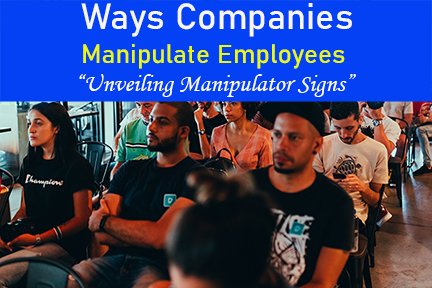Renew your life Today
In the dynamic arena of corporate dynamics, where productivity and profitability take center stage, some companies resort to manipulative strategies. This blog post delves into the darker realms of organizational psychology, exposing 12 prevalent manipulator signs that companies employ to manipulate their workforce.
Exploitative Work Environments
Exploitation, one of the telltale manipulator signs, tends to flourish in certain work environments. Here, companies subtly encourage extensive overtime without proportionate compensation, deftly taking advantage of employees’ unwavering dedication and commitment. This creates a delicate balance where loyalty becomes a mere pawn in the manipulator’s strategic game.
Toxic Leadership Styles
Leadership profoundly shapes a company’s culture, and toxic leadership stands out as a glaring manipulator sign. Fear and intimidation become wielded tools to maintain control, leaving a workforce that is not just stressed and demoralized but profoundly impacted on both individual and collective levels. Identifying these manipulator signs is critical for preserving not only individual well-being but also the overall health of the organizational culture.
Misleading Communication
Transparency forms the bedrock of trust within any organization. Manipulative companies often deploy misleading communication strategies, leaving employees uninformed about significant decisions or changes. This lack of transparency fosters an environment where manipulator signs, such as rumors and misinformation, can flourish, gradually eroding trust and undermining employee morale.
Isolation and Alienation: Manipulator Signs in Division
Creating divisions among employees emerges as a pivotal manipulator sign. By encouraging isolation, manipulators hamper the formation of strong bonds, making it easier for them to control the flow of information within the organizational structure. This deliberate distancing tactic not only impedes collaboration but also hinders the emergence of a unified and resilient workforce.
Unrealistic Expectations
Setting unattainable goals emerges as a subtle yet significant manipulator sign. Employees continually facing pressure to meet unrealistic targets experience not only stress and burnout but also a pervasive sense of inadequacy. This manipulation tactic capitalizes on employees’ innate desire to excel but sets them up for failure, revealing clear manipulator signs at play within the company’s modus operandi.
Surveillance and Micro-Management
Micromanagement and excessive surveillance carry clear manipulator signs, systematically eroding trust and autonomy within a workplace. Companies implementing intrusive monitoring systems create an atmosphere of fear, stifling creativity and making employees feel as if their every move is under constant scrutiny.
Conditional Rewards
Conditional rewards wield manipulator signs as powerful tools. Tying bonuses or promotions to arbitrary conditions compels employees to conform to specific behaviors, fostering a transactional relationship that undermines genuine engagement. This manipulation tactic creates a culture of compliance rather than fostering an environment where employees feel valued and appreciated for their contributions.
Gaslighting: Manipulator Signs in Psychological Manipulation
Gaslighting, a manipulator sign rooted in psychological manipulation, involves causing individuals to doubt their perceptions and sanity. In the workplace, this manipulation may manifest as the denial or trivialization of employees’ experiences. Gaslighting induces not only confusion but also self-doubt, making it challenging for employees to trust their instincts and make informed decisions.
Cultivating Dependency: Manipulator Signs in Limiting Options
Subtly cultivating dependency reveals manipulator signs within a workplace. Discouraging individuals from seeking external opportunities or developing skills creates a sense of entrapment, contributing to a climate where employees feel limited in their options. This manipulation tactic aims to ensure that employees remain tethered to the manipulator’s agenda, fostering an unhealthy sense of reliance.
Selective Information Sharing
Controlling the narrative through selective information sharing is a clear manipulator sign. Companies may choose to disclose only positive news while concealing negative aspects, shaping employees’ perceptions to align with the manipulator’s agenda. This manipulation tactic can influence not only how employees perceive their roles but also their understanding of the overall health of the company.
Inequitable Compensation Practices
Unequal pay and benefits emerge as manipulator signs used to foster competition among employees. Maintaining disparities in compensation diverts attention from systemic issues, creating a hierarchical power structure that serves the company’s manipulative interests rather than fostering a fair and collaborative work environment.
Psychological Testing and Profiling
Some companies employ psychological testing and profiling as manipulator signs that infringe on personal boundaries and compromise the mental well-being of the workforce. Employees may feel exposed and vulnerable, contributing to a climate of distrust and apprehension.
Conclusion
Recognizing manipulator signs within the workplace is paramount for employees seeking to protect their well-being and maintain a healthy work-life balance. This blog post has shed light on 12 manipulator signs, emphasizing the importance of awareness in navigating the complexities of the modern corporate landscape. As we collectively strive for a more transparent and compassionate work environment, cultivating awareness becomes the first line of defense against manipulative practices that compromise the health and happiness of employees.


